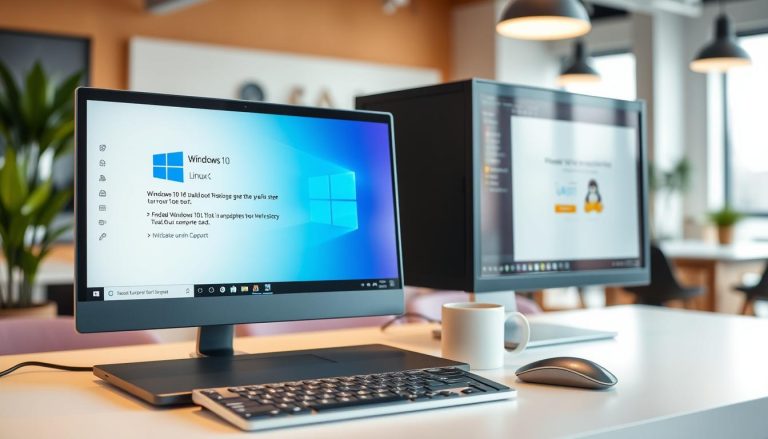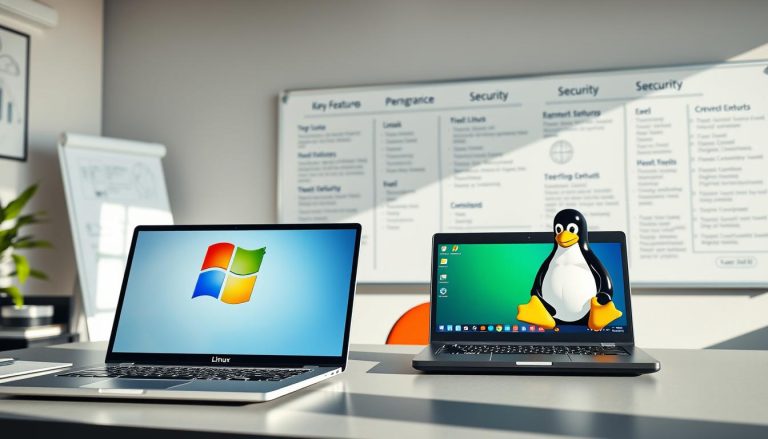What if you could harness the raw power of a native Linux environment directly on your Windows machine, without the complexity of a traditional virtual machine or dual-boot setup? This is the core promise of a powerful feature that bridges two worlds. We created this comprehensive resource to guide you through every aspect of this technology. Our goal is to transform you from a curious beginner into a confident user. You will learn to install, configure, and optimize your chosen Linux distribution for professional development work.
This guide is designed for developers and tech enthusiasts seeking to streamline their workflow. We follow a logical progression, starting with foundational concepts and advancing to real-world scenarios. By the end, you will have a fully functional environment integrated with modern development tools.
You will leverage the strengths of both operating systems seamlessly. This approach makes your daily tasks more efficient and versatile. We focus on practical knowledge you can apply immediately.
Key Takeaways
- Run a native Linux environment directly on a Windows operating system.
- Avoid the overhead associated with traditional virtual machines.
- Follow a step-by-step process for installation and configuration.
- Optimize your chosen Linux distribution for development tasks.
- Integrate modern development tools into your new environment.
- Understand both basic commands and advanced customizations.
- Resolve common issues with our troubleshooting guidance.
Overview of Windows Subsystem for Linux
The ability to execute Linux applications natively on a Windows operating system represents a significant advancement in cross-platform compatibility. This technology eliminates traditional barriers between operating systems.
We’ll explore what makes this solution so valuable for technical professionals. Understanding its core functionality helps maximize its potential.
What is WSL?
WSL serves as a compatibility layer that enables genuine Linux environments directly on Microsoft’s platform. Unlike traditional virtualization like KVM, it operates without separate hardware requirements.
This approach allows installation of various distributions including Ubuntu, Debian, and Kali Linux. Users gain access to Bash command-line utilities and applications.
Key Benefits for Developers and Tech Enthusiasts
The primary advantages include:
- Seamless integration between file systems for easy cross-platform file management
- Native compatibility with Linux-specific development frameworks and toolchains
- Elimination of dual-boot configurations while maintaining both environments
- Enhanced productivity through access to comprehensive command-line utilities
This environment proves particularly valuable for open-source projects targeting Linux servers. It provides accurate simulation of production conditions.
Prerequisites and System Requirements for Installing WSL
System compatibility forms the foundation for successful implementation of this cross-platform technology. We’ll guide you through verifying your setup meets all necessary specifications.
Supported Windows Versions and Build Requirements
Your computer must run specific operating system releases for streamlined setup. The simplified command method requires Windows 10 version 2004 or newer (Build 19041+) or any Windows 11 release.
Check your current operating system details through system information. This verification ensures you meet minimum requirements before beginning the installation process.
Type wsl -l -v in a terminal to see if this feature already exists on your machine. The command displays installed distributions or indicates configuration is needed.
Enabling the Required Windows Features
Some systems require manual activation of specific components. If you encounter the WSL_E_WSL_OPTIONAL_COMPONENT_REQUIRED error, enable the optional feature through Control Panel.
Navigate to Programs and Features, then select “Turn Windows features on or off.” Mark the checkbox beside Hyper-V to activate necessary virtualization capabilities.
For WSL 2, you may also need the Virtual Machine Platform component. Restart your computer after enabling these features to ensure proper configuration.
How to Use Windows Subsystem for Linux: Step-by-Step Installation Guide
Modern Windows versions offer a remarkably streamlined approach to setting up this Linux compatibility layer. The process has evolved from complex manual configurations to a single-command operation that handles most requirements automatically.
Executing the WSL –install Command
We recommend beginning with the simplified installation method available on current systems. Open PowerShell with administrator privileges by right-clicking the Start menu and selecting “Run as administrator.
Enter the wsl –install command in the terminal window. This single instruction enables all necessary features and downloads the default Ubuntu distribution. The system automatically configures the Virtual Machine Platform and other required components.
After the installation completes, restart your machine for changes to take effect. This critical step ensures proper functionality of the newly installed environment.
When you first launch your Linux distribution, a console window appears. The system decompresses files and sets up the initial environment. Future launches occur almost instantly.
Manual Installation Options for Older Windows Versions
For systems that don’t support the simplified command, alternative methods exist. Older Windows releases require manual enabling of specific features through the Control Panel.
Navigate to “Turn Windows features on or off” and enable the required components. You can then download distributions directly from the Microsoft Store or use .wsl files for offline installation.
If the standard installation process encounters issues, try the web-download method using wsl –install –web-download -d DistroName. This alternative pathway often resolves hanging installation problems.
Configuring Linux Distributions and Default Settings
After installation, the real power of your environment comes from tailoring it to your specific workflow. We guide you through selecting your preferred Linux distribution and customizing essential settings.
Changing the Default Distribution with the -d Flag
The initial setup typically installs Ubuntu as the default distribution. You can specify a different environment during installation using the -d flag.
View all available options by running wsl.exe --list --online in PowerShell. This command displays distributions like Debian, Kali Linux, and OpenSUSE available through the Microsoft Store.
Install your chosen distribution using wsl.exe --install -d DistroName. After installation, set it as your default with wsl.exe --set-default DistroName. This determines which environment launches when you type wsl.
Customizing the Home Directory in WSL
Your home directory typically points to /home/username by default. You can change this path to better integrate with your existing file structure.
Edit the user account database using sudo vim /etc/passwd. This plain text file contains information for all user accounts on the system.
Remember the proper notation for Windows paths: prepend with /mnt/ and use forward slashes. For example, C:\ becomes /mnt/c.
Press i to enter insert mode, modify the home directory path in the last row, then press Escape and type :wq to save. Exit and reopen your environment for changes to take effect.
Verify your new home directory by running pwd after restarting. This confirms your customized path functions correctly.
Exploring Basic WSL Commands and File System Navigation
Effective navigation and file management form the foundation of productive work within any command-line interface. We’ll guide you through essential operations that make your environment truly functional.
Essential Bash Commands for Daily Use
Linux commands typically follow this pattern: command [OPTIONS] arguments. The command specifies the action, while options modify behavior and arguments identify targets.
Start with navigation fundamentals. Use pwd to see your current directory path. The cd command moves you between locations—cd ~ returns to your home directory.
View directory contents with ls. Try ls -la for detailed listings including hidden files. Create new directories using mkdir and files with touch.
Managing Files and Directories Across Windows and Linux
File operations maintain workflow continuity. Copy files with cp, move or rename with mv, and remove with rm.
Windows drives mount under /mnt/—your C: drive becomes /mnt/c. This allows seamless file access across both systems.
Always consult documentation using man command or command –help. These resources provide complete usage details for any terminal operation.
Setting Up a WSL-Based Development Environment
Professional developers maximize productivity by establishing seamless connections between their editing tools and execution environments. We guide you through configuring an integrated workspace that leverages the strengths of both platforms.
Integrating VS Code with WSL
The Visual Studio Code WSL extension transforms your coding experience. It runs commands and extensions directly within the Linux environment, eliminating cross-platform compatibility issues.
Connect to your workspace by opening a terminal and navigating to your project directory. Type code . to launch VS Code with full WSL integration. The first execution automatically installs necessary server components.
Alternative connection methods include using the Command Palette (F1). Select “WSL: Connect to WSL” for your default distribution or specify a particular environment.
Optimizing Workflow Using Linux-Specific Toolchains
Leverage native Linux compilers, build tools, and package managers directly within your editor. This approach ensures accurate simulation of production conditions.
VS Code terminals automatically run in the WSL environment when connected. You gain seamless access to Linux commands while maintaining full IntelliSense capabilities and debugging features.
Organize your project files strategically across the integrated file system. Consider using Linux-native tools for projects that will deploy to containerized environments.
Managing Multiple Linux Distributions on Windows
One of the greatest strengths of this technology lies in its ability to host multiple independent Linux environments. You can install as many different distributions as needed for various projects and testing scenarios.
This flexibility allows specialized setups for different purposes. You might run Ubuntu for general development work while maintaining Kali Linux for security testing.
Running and Switching Between Distros
We recommend Windows Terminal as your primary interface for managing multiple environments. It supports various command lines in tabs or split panes, enabling quick switching between different Linux distributions and other shells.
Several methods exist for launching your installed distributions:
- Type the distribution name in the Windows Start menu
- Enter the distribution name directly in PowerShell
- Use
wsl.exefor your default environment - Run
wsl.exe --distribution DistroNamefor specific instances
The command wsl -l -v displays all installed distributions with their running status. This provides a comprehensive overview of your multi-distribution setup.
For advanced scenarios, consider setting up multiple WSL distribution instances with custom configurations. This approach maximizes flexibility across different development workflows.
You can execute single commands in specific distributions without fully launching them. The syntax wsl -d DistroName command runs the command and returns to your current shell.
Troubleshooting and Common WSL Issues
Even with streamlined installation processes, technical environments can occasionally present challenges that require specific solutions. We provide clear guidance for resolving frequent obstacles users encounter.
Our troubleshooting approach focuses on practical steps you can implement immediately. This ensures your development environment remains stable and efficient.
Resolving the WSL_E_WSL_OPTIONAL_COMPONENT_REQUIRED Error
This specific error indicates missing required components. The system cannot proceed without enabling these features first.
Navigate to Control Panel > Programs and Features. Select “Turn Windows features on or off.” Locate both “Windows Subsystem for Linux” and “Virtual Machine Platform.” Ensure both checkboxes are marked.
Restart your computer after enabling these components. This action resolves the error and allows proper functionality.
Upgrading Between WSL 1 and WSL 2
Verify your current version using the wsl -l -v command. This displays essential version information for all installed distributions.
WSL 2 offers significant performance improvements through actual Linux kernel virtualization. Upgrade existing installations with wsl.exe –set-version DistroName 2.
Set your preferred version as the default for future installations. Use wsl.exe –set-default-version 2 to ensure new distributions automatically use WSL 2.
For comprehensive troubleshooting guidance, consult official documentation. This resource addresses additional scenarios beyond common errors.
Advanced WSL Tips and Customizations
Customization transforms your development environment from functional to exceptional. We explore advanced techniques that maximize productivity and streamline workflows.
These optimizations bridge the gap between basic operation and professional-grade efficiency. They leverage the full potential of integrated platforms.
Using PowerShell Commands within WSL
Cross-platform interoperability reaches new heights with command integration. Execute PowerShell instructions directly from your Linux environment.
The Get-Date command reveals Windows system time, while wsl date shows Linux timing. This demonstrates seamless data exchange between operating systems.
Run Linux commands from PowerShell without launching separate windows. Use wsl [command] syntax for immediate execution in your default distribution.
Automating Tasks with Bash Scripts and .bashrc
The .bashrc file automatically configures your terminal environment upon startup. Trigger it manually with source ~/.bashrc after modifications.
Customize this script with:
- Aliases for frequently used commands
- Personalized environment variables
- Modified PATH configurations
- Custom prompt designs
For VS Code integration, use the server-env-setup script. It processes before the server starts without shell startup complications.
Customizing the Windows Terminal for an Enhanced Experience
Windows Terminal offers extensive customization options for different distributions. Modify the settings.json file to define appearance and behavior.
Configure color schemes, font styles, and keyboard shortcuts. Set default profiles and starting directories for each environment.
These advanced customizations create a truly personalized development system. They optimize both visual appeal and functional efficiency.
Conclusion
This comprehensive exploration has equipped you with the essential knowledge to master a powerful cross-platform development solution. We’ve guided you through every aspect of this technology, from foundational concepts to advanced customizations.
The windows subsystem successfully bridges two operating system environments on a single machine. This eliminates traditional barriers while maintaining full functionality of both platforms.
Our guide covered critical steps including installation, configuration, and optimization. You learned to manage multiple linux distribution choices and integrate essential tools. Mastering this environment involves understanding both basic operations and advanced features.
The ecosystem continues to evolve with new versions and enhanced capabilities. Stay informed through official documentation to maximize your development workflow. You now possess a fully functional setup ready for professional use.



